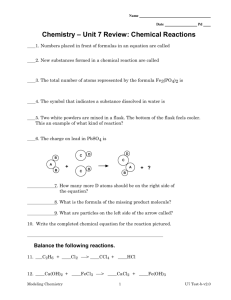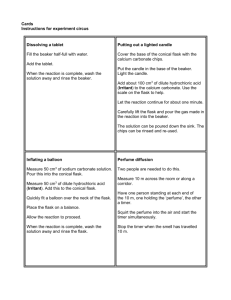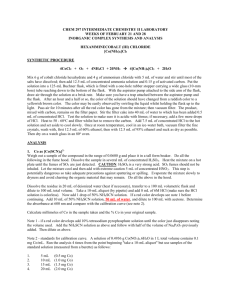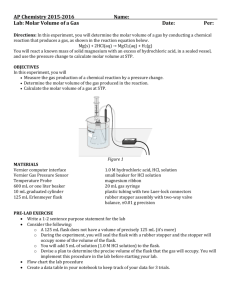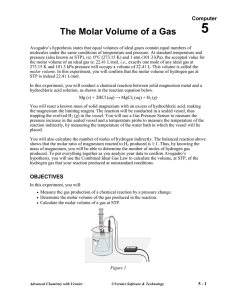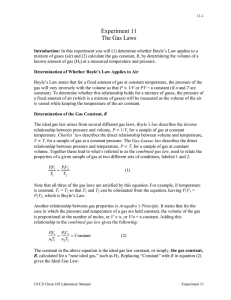The Molar Volume of a Gas
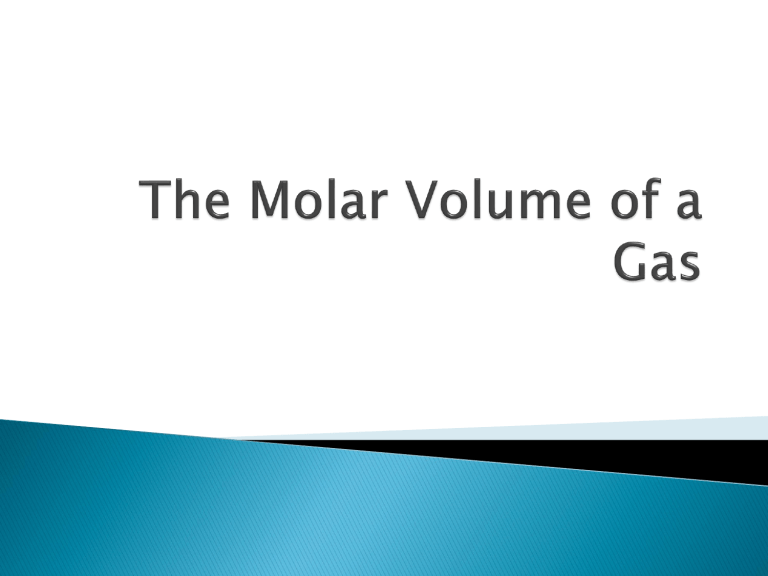
In this experiment we will be determining the molar volume of a gas. (meaning the volume that one mole of gas should occupy)
We will use the following reaction to do this.
Mg(g) + 2 HCl(aq) MgCl
2
(aq) + H
2
(g)
We will react a known mass of solid magnesium with excess HCl in a closed container and use the pressure change to calculate the molar volume.
Determine the gas produced by a chemical reaction by measuring the pressure change.
Determine the molar volume of the gas produced in the reaction.
Calculate the molar volume of a gas at STP
(should be 22.4)
Netbook
Labquest
Temperature probe
Gas pressure sensor
600 mL Beaker
10 mL graduated cylinder
125 mL Erlenmeyer flask hydrochloric acid (HCl)
100 mL Beaker
Magnesium ribbon
20 mL syringe
Plastic tubing
Rubber stopper with 2-way valve
Digital balance
Ring stand
Clamp
All HCl solutions are harmful to skin and eyes. Gloves and goggles should be worn at all times.
Follow Mr. Berger’s instructions to determine the volume of your flask.
Obtain a piece of magnesium ribbon. Measure and record its exact mass. Place it in a clean, dry
125 mL Erlenmeyer flask.
Put the flask in the 600 mL beaker and fill the beaker with room temperature water.
Connect the gas pressure sensor to the labquest.
Put the white stopper with the valve into the opening of the flask. Make it is on tight. Make sure the blue valve is closed by turning it to the perpendicular position.
Obtain a small amount of HCl in you 100 mL beaker.
Draw 5 mL of the HCl solution into the 20 mL syringe.
Attach the syringe to the white stopper carefully.
Submerge the flask in the water bath.
Record the initial pressure in the flask in your data table.
Record the temperature of the water in your data table.
Press the collect button. After a few seconds open the two way valve and slowly press the plunger to add all of the HCl.
Pull the plunger back to its original position then close the valve.
Observe the reaction and how the pressure in the flask changes.
Record the maximum pressure attained in the flask in your data table.
Clean and dry your flask before doing trial 2 and use a new piece of magnesium (don’t for get to weight it first.)
Mass Mg (g)
Volume of flask (mL)
Initial Pressure (kPa)
Maximum Pressure
(kPa)
Change in pressure
(maximum – initial)
Temperature (Kelvin)
Trial 1 Trial 2
1.
2.
3.
4.
Calculate the moles of each piece of magnesium that you used.
Calculate the molar amount of hydrogen that was produced in your reactions. (Using stoichiometry)
Calculate the volume of one mole of hydrogen gas at STP.
Your answer to question 3 should have been
22.4 L/mol. Are you values close? Provide some explanation as to why you didn’t calculate exactly 22.4 L/mol

